

Which one is native to Singapore?
(Left: Photo by kwokwai76)
(Right: Photo by flipkeat)
It's a running gag among nature enthusiasts in Singapore that many members of the public are ignorant of our own wildlife, and that even common native species are bound to get confused with species not found locally. As a result, our monitor lizards become "Komodo dragons" or "iguanas", agamid lizards are "chameleons", sunbirds are mistaken for "hummingbirds", egrets and herons are "cranes" or "storks", our otters are "sea otters", and these are the most obvious errors we've heard of so far.
It is saddening that many people seem to be more familiar with wildlife found in other parts of the world. Perhaps it's because of the prevalence of wildlife documentaries focusing on ecosystems and species found on other continents, or the infusion of American pop culture. Faced with a small, vaguely cat-like mammal in their gardens or on their rooftops, with a dark eye-mask, it's not surprising that some local residents think that they have seen a common raccoon (Procyon lotor), when in fact this is a species native only to North and Central America. In most cases, any reports of "raccoons" in Singapore are likely to be misidentified common palm civets (Paradoxurus hermaphroditus).
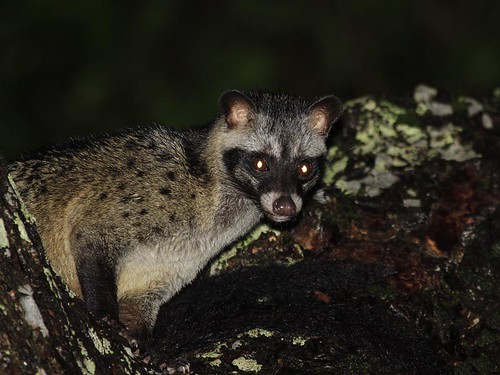
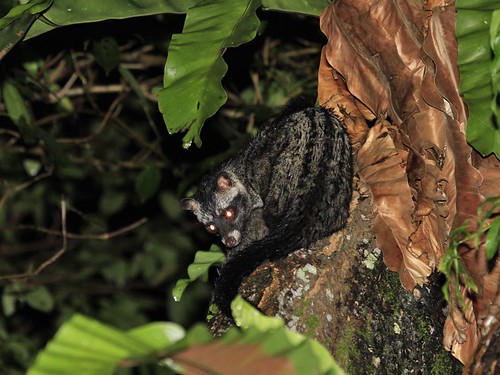
Common palm civet;
(Photos by kwokwai76)
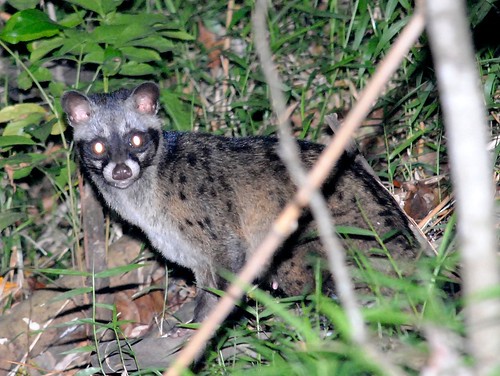
Common palm civet, Siglap;
(Photo by Kok Sheng)
Besides raccoons, another recent sighting of what was said to be a "Mexican coati" raises the question of whether people are simply oblivious or ignorant of all the readily accessible information about Singapore's wildlife. Of course, without a good photograph, the most likely answer is that it's yet another common palm civet.
Raccoons and coatis are both members of the Procyonidae, a small family of 15 species found only in the Americas. The bulk of their diversity is found in tropical Central and South America. Closely related to other small carnivorans like the weasels, badgers, and otters (F. Mustelidae), and the skunks (F. Mephitidae), the procyonids comprise several species known for their omnivorous diets.
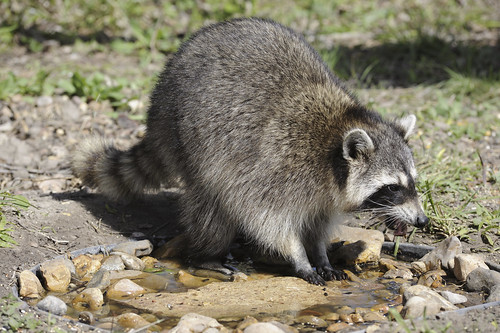
Common raccoon, Texas;
(Photo by peskador_X)
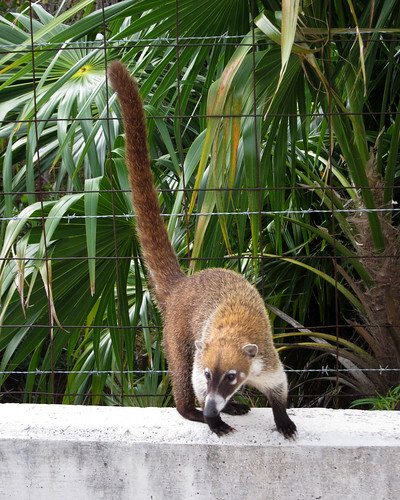
White-nosed coati (Nasua narica), Mexico;
(Photo by kathryn.weiss)
According to this ZooChat forum thread from 2010, Wildlife Reserves Singapore has (had?) a number of procyonid species in their collections. The Singapore Zoo used to have common raccoons on exhibit, although apparently they are no longer on display. A pair of common raccoons do make an appearance in the Creatures of the Night show at the Night Safari.

Common raccoons, Singapore Zoo;
(Photo by valentinokh)
The Rainforest Fights Back show at the Singapore Zoo features a brown-nosed coati (Nasua nasua) among its animal performers. This species replaces the white-nosed coati in South America; the latter species lives in Central America and the southern United States.


(Photos by Steel Wool)
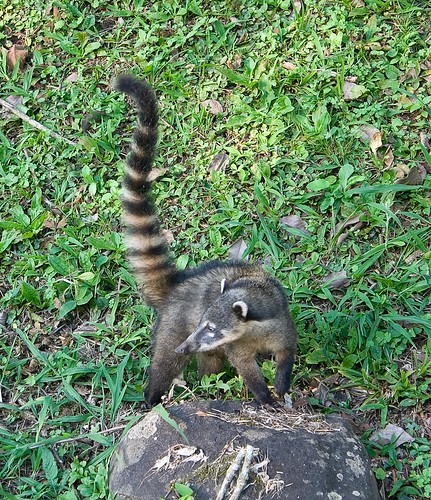
Brown-nosed coati, Brazil;
(Photo by Brian Ritchie)
Another species supposedly in the collections, but which is not on exhibit, is the crab-eating raccoon (Procyon cancrivorus). This species is found in forests and wetlands of tropical Central and South America, from Costa Rica to Argentina. The Central American portion of its range overlaps with that of the common raccoon. The common raccoon itself is arguably one of the most successful procyonids, and can be found in the wild from the deciduous woodlands of Canada to tropical forests in Panama.

Crab-eating raccoon, Brazil;
(Photo by Gaia Dell'Ariccia)
One final species of procyonid listed as being in the collections (albeit off-exhibit) is particularly notable, as it is quite a unique creature in many ways. It is the kinkajou (Potos flavus).


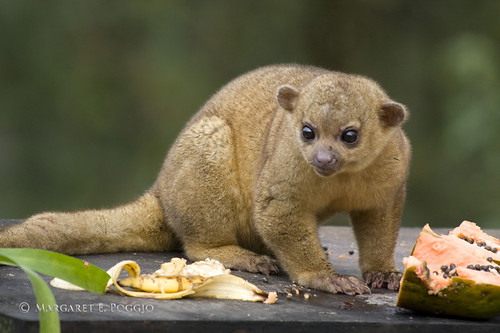
Kinkajou, Costa Rica;
(Photos by ppoggio2)
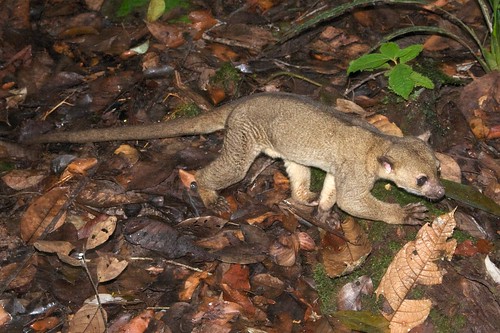
Kinkajou, Brazil;
(Photo by jmittermeier)
Found in tropical forests from Mexico to southern Brazil, the kinkajou is a highly arboreal and nocturnal animal. Despite its carnivorous ancestry, the kinkajou's diet is made up mostly of fruit and nectar from flowers, which it reaches with its long tongue. It is believed to be an important pollinator and seed disperser for some plant species. Insects such as ants are also consumed, and may be seasonally important. So far, unlike the omnivorous raccoons and coatis, the kinkajou is not known to feed on eggs or small vertebrates.
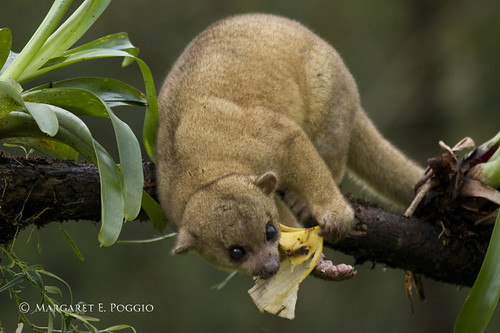
(Photo by ppoggio2)
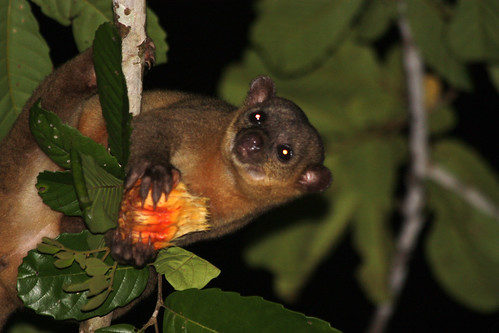
(Photo by thechemnerd)
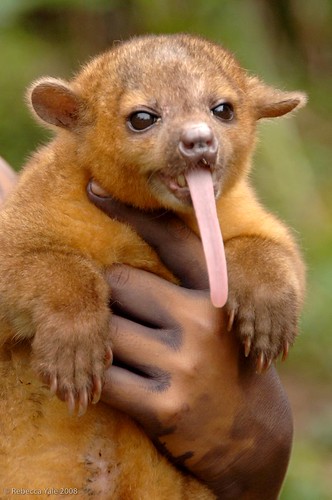
(Photo by Yale_Rebecca)
In its appearance, diet, and habits, the kinkajou appears similar to many of the palm civets of Asia, and can perhaps be seen as an example of convergent evolution; its physical appearance alone is highly reminiscent of the small-toothed palm civet (Arctogalidia trivirgata).

Small-toothed palm civet, Fraser's Hill;
(Photo by Vilma)
Like many New World monkeys such as spider monkeys (Ateles spp.) and capuchins (Cebus spp.), the kinkajou has a prehensile tail, serving as an extra limb to help it climb, even allowing it to hang from branches.
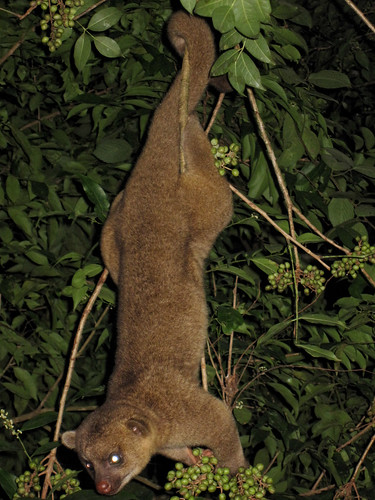
(Photo by thedamian)
Through another quirk of convergent evolution, the only other carnivoran with a prehensile tail is the largest of the arboreal Southeast Asian palm civets, the binturong (Arctictis binturong).
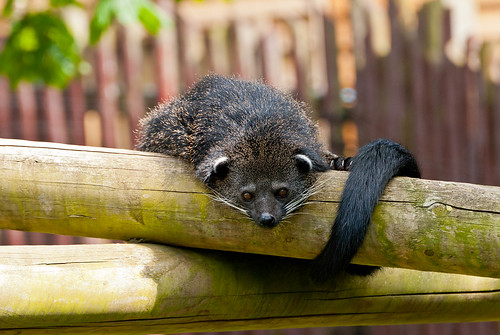
Binturong, Colchester Zoo;
(Photo by 14nelson)
The kinkajou's lifestyle and habits are shared by another group of procyonids, the 5 species of olingos (Bassaricyon spp.), which are also arboreal, largely frugivorous inhabitants of tropical forests in Central and South America. Despite this similarity, olingos are apparently more closely related to the coatis, whereas kinkajous are more distant kin, representing a basal offshoot of the common ancestor of all extant procyonids. Unlike the kinkajou, an olingo does not have a prehensile tail.
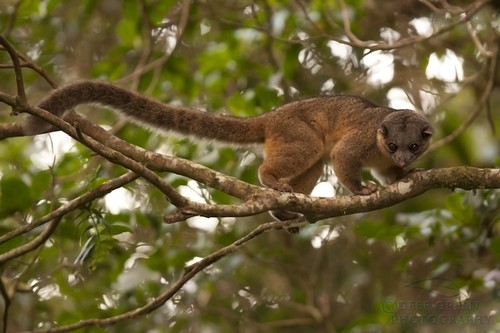
Bushy-tailed olingo (Bassaricyon gabbii), Costa Rica;
(Photo by Deep Green Photography)
Kinkajous are available as pets in some countries, and there are a number of people in the United States specialising in exotic pets who are breeding and raising kinkajous for the pet trade. However, like many other wild animals, owning a kinkajou can be challenging and expensive.
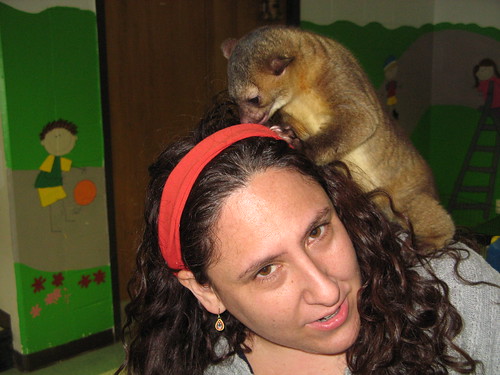
Pet kinkajou;
(Photo by meyerweb)
The upside of a pet kinkajou is that it is generally quiet and docile, with no noticeable odour. Still, a kinkajou will tend to be more active and playful at night, clambering everywhere and even pouncing from high places. A tame kinkajou is highly intelligent, curious, and affectionate towards its owners, but will require plenty of space to roam and climb about, which means that it is prone to breaking things as it wanders around the house, or leaving scratch marks on furniture (and owners) with its sharp claws. It is not meant to be kept in a small cage all day long, and will either require a large cage or be allowed to spend plenty of time exercising and exploring outside the cage while under strict supervision. Some owners even set aside an entire room full of toys and objects to climb, all just for their kinkajou.
Their nocturnal habits mean that trying to force a kinkajou to become diurnal to suit the owner's lifestyle might lead to exhaustion and stress, or even crankiness and a tendency to nip when woken up. It is recommended that a pet kinkajou be spayed or neutered before it reaches sexual maturity, as it might have a higher chance of turning aggressive as it reaches adulthood. Also, toilet-training a kinkajou seems to be a real challenge; one learns that it is simpler to just place litter-boxes beneath favoured perches. Proper socialisation and lots of loving attention are necessary, so as to ensure that the kinkajou forms a bond with its owner and does not turn aggressive. As a result a dedicated kinkajou owner is advised to spend many hours every day with his or her pet. On top of that, kinkajous can be long-lived, living an average of 23 years in captivity. This is certainly not an animal for those without the time or commitment.

(Photo by Lifted Spirit)
One particular pet kinkajou attained a fair bit of fame after it bit its owner, who was none other than Paris Hilton.

(Photo from Wetpaint Entertainment)
Another possible problem with having a pet kinkajou is the risk of zoonotic infections, which can occur when an infected kinkajou bites its owner. Given that we often know little about the pathogens and parasites that these exotic animals carry (aside from those already known to affect domestic pets like dogs, cats, and ferrets), owning a wild animal like a kinkajou can be risky. The raccoon roundworm (Baylisascaris procyonis), which is typically a parasite of wild raccoons, can also be carried by kinkajous (after all, kinkajous and raccoons are quite closely related), which presents another possible health issue for pet owners if strict hygiene measures are not followed.
Due to the level of commitment needed to take care of a pet kinkajou, as well as their tendency to get nippy, there are many stories of pet kinkajous being sent to rescue centres and animal sanctuaries, or possibly being abandoned. They may be cute, but it certainly seems like kinkajous are not "easy" pets at all.
The kinkajou is currently considered to be of Least Concern in the IUCN Red List. It's not known if hunting for the pet trade is a significant threat to wild populations, although deforestation and local hunting for meat and fur might also be important factors. Like all other exotic mammals, the kinkajou is not allowed as a pet in Singapore. However, as we've seen in an earlier post on green iguanas, some exotic pets still manage to get smuggled in, which explains this recent posting on a local classifieds website:

Baby Kinkajou needs new home (Sg)One does wonder how the owner managed to obtain a pet kinkajou in the first place, and how it was smuggled into Singapore. It's also a little surprising to see someone flouting pet ownership laws so openly, without fear of attracting unwanted attention from the authorities.
I am moving out and cannot take my little baby kinkajou with me due to many pets already going with me. Her name is Holly and she is 2 months old female Kinjkajou baby. She is very tame and loving. She really likes strangers for some odd reason, but prefers females. I am going to be very picky on her new home. Her current cage is 12ft tall by 7ft wide and inside. She just started eating food though still on bottle 3 times daily. I will include her cage if you want to help take apart, also included her toys, blankets, food, diapers, treats etc. She has been vet checked and has been TB tested and fecal tested recently. I am sad to see her go and know you will love her as much as i do. Please do not even think of taking her in, unless you can be with her at least 5+hrs a day & plan to keep her with you when traveling.
This is the first time I've ever heard of someone in Singapore with a pet kinkajou; most previous reports have involved reptiles, arachnids such as tarantulas and scorpions, or the more 'usual' mammals such as ferrets (Mustela putorius furo), hedgehogs (Atelerix albiventris x algirus), sugar gliders (Petaurus breviceps), and even slow loris (Nycticebus spp.). It may seem strange that an animal like the ferret, which has been domesticated for at least 2,000 years, would be considered 'exotic' wildlife. Similarly, sugar gliders and hedgehogs are bred in large numbers in captivity in other countries. However, the Agri-food & Veterinary Authority (AVA) has chosen to exercise caution, and cites the following reasons for restricting the trade and ownership of these and other species as exotic pets:
- They may introduce and spread diseases to humans and domestic animals.
- Collection of wild animals for trading will lead to ecosystem imbalance and threaten the survival of endangered species.
- The welfare of the animals may be compromised due to reasons such as unsuitable living conditions, poor diet and pet owner's lack of knowledge of the proper care for the animal.
- Singapore's biodiversity would be greatly affected if such exotic pets were released in the wild, as most of them are non-native.
- If the animal escapes, it may cause nuisance, fear and trauma to the general public.

Chipmunk For SaleThe chipmunk species most often kept as a pet is the Siberian chipmunk (Eutamias sibiricus). Found across northern Asia from Russia to China, Korea, and Hokkaido in Japan, this is the only chipmunk species occurring outside of North America.
Selling my Chipmunk with Cage
Healthy...tame..plyfull
Selling Prz $350neg
Do sms hp no [redacted]
Breed: Chipmunk PureBred
Age: 10 Months
Sex: Male
Primary Color: Chocolate
Secondary Color: Gold
Advertiser: Owner
Price: $350 Neg.

Siberian chipmunk;
(Photo by Houston Chandler)
Like a slew of other exotic rodents that are becoming increasingly popular in recent years, the trade and ownership of chipmunks in Singapore is at best questionable. Some could plausibly be categorised together with domesticated mice, hamsters, or gerbils, despite belonging to completely different species. It's certainly an aspect of the pet trade that should be looked into and refined, especially since there is likely to be confusion regarding the importation, sale, and ownership of these exotic rodents, especially if they are similar to species already allowed in Singapore.
In an ideal situation, in the hands of people aware of the responsibility and requirements, some exotic animals CAN make great pets. Given enough demand, as well as captive breeding efforts (with the inevitable colour mutations and other fancy varieties), some species could logically end up being counted among the more conventional pets in future. However, the reality is that many of these animals are still bought simply for the novelty factor, for people to show that they have the resources to keep and rear something exotic or different. Not that there's anything inherently wrong with that mentality, but it probably also means that many exotic pets are being kept in less than ideal conditions, and are not receiving the basic level of care needed to thrive in a captive environment, no matter how suitable they may be as pets. When you consider that there are already too many people out there who shouldn't even be allowed to raise a hamster or guppy, let alone a dog or cat, perhaps it is indeed better to err on the side of caution and work on improving the welfare of those animals already allowed as pets.
Pet Gambian pouched rat (Cricetomys gambianus). This is a huge rat.
Here are some recent news articles regarding the illegal wildlife trade in Singapore, much of which involves cracking down on sellers and owners of exotic and illegal pets.
Sting operation nabs online sellers of illegal animals
Animal smuggling on the rise in Singapore
Home's no place for wildlife in Singapore
Still a growing problem: Animal Criminals
Drop in illegal wildlife trade here
Illegal wildlife trade in Singapore active despite heavy penalties
AVA nets 48 exotic animals in island-wide raid
Note: All ads in this post are real, and were found through a simple Google keyword search. Contact details and website links have been removed so as to avoid helping people who might actually want to obtain an exotic and illegal pet.